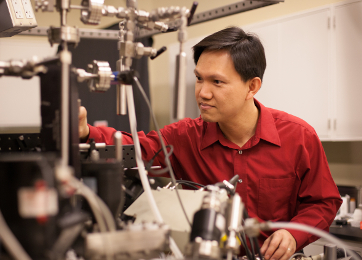
Molecules can move far too quickly to be captured by traditional imaging tools, as quickly as a femtosecond, or one quadrillionth of a second.
Ding-Shyue (Jerry) Yang, assistant professor of chemistry at the University of Houston, is seeking to change that with his work involving the movement of energy and charge across the interface of different materials. To further his research, he has been awarded a CAREER grant from the National Science Foundation (NSF).
NSF CAREER grants are competitive awards to junior faculty who exemplify the role of teacher-scholars through their research and teaching. The five-year, $570,332 grant will fund Yang’s research, as well as provide support for his work with the Chemistry Olympiad and other outreach to high school students.
Dan Wells, dean of the College of Natural Sciences and Mathematics, said the award offers validation of Yang’s work on both issues.
“This NSF CAREER award recognizes the cutting-edge experiments Dr. Yang is doing to understand the structure and motion of molecules on surfaces, such as those found in catalytic processes and lubricated materials,” Wells said. “The award will also allow him to continue his science outreach to high school students in the Houston area, helping to build the STEM pipeline that is so important for the future.”
Yang uses ultrafast electron diffraction and time-resolved scanning electron microscopy, relatively new tools that, along with new experimental methods he is developing in his lab, can allow researchers to directly visualize the movement in greater detail than with traditional spectroscopy, he said. “Think of a camera with a mechanical shutter that can move only so fast,” he said. “Molecules move at picoseconds and at femtoseconds. Much faster than the fastest camera on the market that we can use to image the molecular world."
Yang began the work at the California Institute of Technology, where he earned his Ph.D. and worked as a post-doctoral researcher and research scientist before arriving at UH in 2012.
New technologies and experimental methods are allowing researchers to better understand how energy or a charge is transferred across materials at the interface – the area where they are joined – and will have applications for nanotechnology, catalytic processes and other fields, he said.
Yang is also recognized for helping high school students understand all that chemistry has to offer, opening his lab for student tours, employing high school student interns under a Welch Foundation program and serving as coordinator for the international Chemistry Olympiad competition.
The Olympiad is a pet project – Yang was a gold medal winner representing Taiwan in 1993, as he was preparing to enter college. He hadn’t realized chemistry had much to offer beyond the beakers and test tubes of his high school classes and planned to study mathematics. During the competition, as he met with researchers in the field, he said he realized it was far more complex and fascinating.
His life’s work was set, and he wants to pass that along.
“I want students to see the variety of things involved in chemistry,” he said.